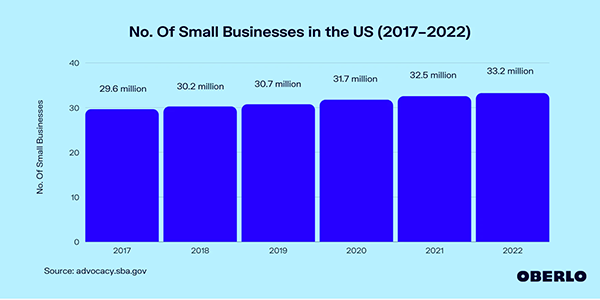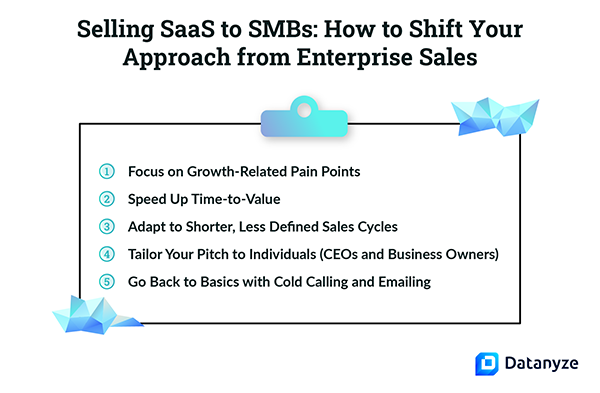
Selling SaaS to Small Business: 6 Tips to Overcome Hurdles Sarah Chan Rejante May 02, 2023
In the cutthroat sales world, every salesperson feels pressured to chase higher dollar-value deals, so it's tempting to focus your sales efforts on the "biggest fish."
While large deals bring in a lot of money at once, sales teams shouldn't forget about the small business market.
99.9% of American businesses are small. That’s about 33.2 million businesses. A market this large shouldn’t be neglected; it should be highlighted.

Graph: Number of small businesses in the US (2017 - 2022), by Oberlo
So why does this market remain largely untapped, particularly by SaaS businesses?
This may sound like a no-brainer to some, but convincing sales managers and C-Suite executives to get on board can be challenging. They speak in numbers, and approaching small businesses can be risky in the long term.
The vast majority of small businesses don't last. Data from the U.S. Bureau of Labor Statistics (BLS) shows that 20% of new businesses fail within the first year, and 45% don't make it past five years.
If you’re looking to build long-lasting client relationships, these aren’t the odds you want to gamble with.
Small businesses often also have smaller budgets, so they’re difficult to win over. Even the best salesperson will struggle to close a deal with a company that is reluctant to spend.
Selling SaaS to small businesses can be a daunting task for many. That's why we've put together a helpful guide to boost your SaaS sales.
Keep reading below if your SaaS business is looking to gain more small business clients.
To start, let's refresh our memory with a few definitions.
What is “SaaS”?
"Software as a Service" is a software solution that offers users access to applications over the Internet. SaaS is usually hosted on the cloud and moderated by the provider. Most SaaS products are offered through a paid or freemium subscription.
These applications are available through a website or app, and they don’t require a lengthy installation process or ongoing routine updates. Instead, the SaaS provider manages everything behind the scenes.
You may have heard of Salesforce, Slack, Dropbox, and Zoom. Each of these is an example of a SaaS company.
What are SMBs?
Small and medium businesses (SMBs), also known as small or medium enterprises (SMEs), are corporations, partnerships, or sole proprietorships that fall below a specific threshold of annual revenue and total number of employees.
While this figure can vary, Gartner sets the bar at fewer than 100 employees for small businesses, and fewer than 999 for medium businesses.
Small businesses generally bring in less than $50 million per year, while medium-sized businesses usually make less than $1 billion.
For the purposes of this article, we'll mainly be focusing on small businesses, but much of what we'll talk about can also apply to medium-sized businesses.
What is different about selling to a small business, as opposed to a large corporation?
Aside from the number of employees and annual revenue, there are a few other factors to consider when selling SaaS to small business owners.
These are the top 5 key differences you should keep in mind when planning to sell SaaS to small and medium businesses:
1. Go big or go home—SMBs are less concerned about saving money and more likely to invest in growth

There are many myths about SMB sales, one of the main ones being that small businesses don't want to spend money.
While most people would assume that smaller businesses would be more frugal, taking their financial situation into account, the opposite is often true. SMBs need to grow to survive.
Large businesses are more likely to be stringent with their budget than smaller businesses. Once a business has reached a comfortable size, it often shifts its focus to streamlining its processes, shedding excess spending, and achieving financial efficiency.
SMBs, on the other hand, are more likely to see value in investing in growth. Their goal is to grow fast and grow now, meaning they are willing to spend if the result will yield quick and tangible rewards.
2. Less is more—modern prospecting tools don't work on SMBs
If you plan on selling SaaS to small business owners, dust off your old phone lists, because the traditional prospecting methods will go much further.
That’s right—when it comes to SMB sales, cold calls still work. If you’re feeling like your cold outreach skills are a little rusty, here’s a little refresher.
Also, most salespeople naturally gravitate toward LinkedIn when doing social media outreach. While many small business owners are on LinkedIn, most are best reached through Facebook and Instagram, according to this survey by Statista.
So when planning your SMB sales strategy, your tactics should lean heavily into phone and email outreach, as well as social media outreach targeting Facebook and Instagram users.
3. Quick and unconventional—expect a shorter sales cycle and a less defined buying process when selling to SMBs

Don’t expect a typical buying process in SMB sales.
SMBs have less time, fewer resources, and a much faster buying cycle than the enterprise clients you may be used to. This is due to their small size—a less siloed team means they have more freedom to make purchase decisions faster. Large businesses, on the other hand, may be held back by a long approval process.
Small business decision-makers usually prefer to scroll through online review sites to help them make their purchase decision. That means, if you're receiving an inquiry from a small business owner, they've likely already made up their mind.
While this might sound like an easy sell, this isn't exactly the case. Here's why.
Your typical small business decision-makers aren't your average business people. In SMB sales, you're more likely to be dealing with an industry expert than a seasoned business professional.
That means they will likely have less experience using SaaS products and will require more guidance on the finer technical details. Expect to spend more time on training, education, and customer support throughout your relationship with your SMB clients.
If you want to succeed in SMB sales, you should be ready to educate customers and expect a faster sales cycle than you may be used to.
4. Their way or the highway—the SMB buying process is usually built around their CEO or business owner
Enterprise sales strategies often cater to larger groups of decision-makers. SMBs, however, don't have a large labor pool to draw from, so the CEO or owner usually takes charge of the decision-making process.
That means your SaaS sales strategy needs to cater to business owners, rather than multiple decision-makers.
For example, in SMB sales, your marketing and sales strategies should always include a social selling component. As we mentioned before, many small business owners are on LinkedIn, Facebook, and Instagram.
While a broader social media plan is an important part of any SaaS sales strategy, in SMB sales, you can get great results from directly contacting decision-makers on social media. A simple direct message can go a long way in SMB sales.
You can also expect each buying process to vary greatly, both in length and organization. Large companies usually have a structured and organized approach to completing a purchase.
Small and medium businesses may not have the experience or the procedures in place to have a streamlined buying process. Instead, business owners may look to you to lead the way and tell them what the next steps should look like.
5. It's all in the details—the key to selling to SMB customers is knowing their business inside out
You should always do your research before you try to sell SaaS to any business. This is especially important when selling to a small business.
Small business owners appreciate a more personalized selling approach. You're not just selling software; you're selling them an ideal. You're showing them how your SaaS solutions will complement their business and their future goals.
To do this, you need to have a deep understanding of their business, the industry they operate in, and the challenges they face, in order to tailor your SaaS products' value proposition to their business.
Researching prospects can be a time-consuming process. While you may be selling software yourself, that doesn't mean you can't invest in other SaaS products to make your life easier, too.
Real-time personalization tools are a time-saving, convenient way to gain valuable data about your target audience and improve lead generation.
We mentioned before that small business owners tend to do their own research before approaching SaaS companies.
That means there could be potential customers viewing your website right now!
That's why we've compiled a list of some great real-time personalization tools you can use to boost your SaaS sales.
6. Time is money—the shorter the time-to-value, the better, when selling SaaS to SMB customers

When you're selling to a small business, the future is now.
While enterprise customers are focused on meeting long-term goals, SMBs are still uncertain about their distant future.
That means, when offering SaaS solutions to SMBs, your product's time-to-value could be a dealbreaker. SMBs don't have multiple years to wait for results. They want to enjoy the benefits of your SaaS product right away.
Your SMB customers are working on growing into an enterprise, and they are looking for products that will support their goals. It's your job to show them that your SaaS solutions will contribute to their growth.
When you pitch to a small business owner, be sure to include an estimated timeline of what a typical growth pattern will look like when using your product. Allow them to visualize their future working with your SaaS business.
6 tips to sell SaaS to SMBs and startups

Image: SMB sales strategy, by Datanyze
What's the best way to convince a small business to invest in your SaaS company?
Although there's no cookie-cutter definition of success in SaaS sales, there are some proven ways to boost your marketing and sales strategies.
Check out our list of helpful tips to sell SaaS below.
1. Get to know the business and tailor solutions to their unique needs
As we mentioned before, a highly personalized approach will give you a more competitive advantage in SMB sales.
It’s important to understand that a small business has unique needs and challenges that set them apart from your larger enterprise clients.
Solutions that bring success to bigger businesses may not be as effective for smaller businesses.
If you can identify specific pain points your customer is facing and demonstrate how your product can address their challenges, this will set you apart and capture the attention of your SMB customers.
You need to deeply understand the business if you want to convince decision-makers of your SaaS solution’s true value proposition.
2. Position SaaS as a cost-effective solution
Your SaaS product will be more attractive to SMBs if you position it as a cost-saving solution.
SMBs typically have limited resources and are looking to grow. Your SaaS sales strategy needs to emphasize that your solution is the most cost-effective way to do so.
When you pitch to your SMB customer, be sure to highlight how your SaaS product can make their business more efficient, save them time and money, and increase their cash flow.
You may also want to leverage any discounts or savings you can offer, such as a free trial or a freemium model they can take advantage of to try your product.
Want to know more about how to leverage your SaaS company's freemium model? Check out this helpful guide.
3. Show small business owners how your SaaS solution can grow with their business
Can your SaaS solutions stand the test of time?
As SMBs experience rapid growth, they need products that are able to scale and adapt to fit their unique and evolving needs.
SaaS products are great for accommodating these changes, and your sales strategy should highlight that as part of both your short and long-term value proposition.
Small business owners need to know that your product will continue to provide value to their business and adapt as their business grows.
4. Craft a compelling case for how SaaS products are essential for growth

A great SaaS sales strategy needs to demonstrate that your product will not only grow with the company, but also contribute to its growth.
Small business owners want to invest in products that will guarantee them a competitive advantage in the market.
If you position your product as a way to accelerate their growth, increase revenue, and stay ahead in the game, SMB customers are more likely to appreciate the value that you will bring to their business.
Make sure to offer relevant statistics and case studies that demonstrate the growth capabilities of SaaS. You can also include customer success stories and testimonials to help support your pitch.
5. Provide customers with access to comprehensive support and training
Your customer may not have prior knowledge of SaaS products. It's a good idea to offer high-level training and support, especially during the onboarding process.
In order to guarantee maximum value to your customer, you want to emphasize your ability to easily get your product up and running.
Be sure to offer a wide variety of resources, including dedicated customer support, video tutorials, and a comprehensive customer onboarding process, to ensure your customer is getting the most out of your product.
6. Research the industries you’re selling in, and stay updated on the latest industry trends
Your small business customer is more likely to trust in your expertise if you can demonstrate that you understand their business.
Before you pitch to an SMB, research the company you want to sell SaaS to and get to know their specific needs.
You’ll also want to gain a strong understanding of where they do business, including the market they operate in, their industry, the work they specialize in, and more.
You should also continue to stay up-to-date on the latest trends in the market, both in the SaaS industry and your customer’s industry.
What are the challenges of selling SaaS to small businesses?
It can be challenging to sell SaaS to a small business. Sales teams need to be able to adapt to the unique needs of a small business and provide the necessary guidance to support small business owners throughout the process.
While each small business has its own pain points and challenges, there are also many commonalities between them.
Some of the challenges sales teams might experience include:
1. Skepticism about the need for SaaS products
Small business owners may not fully understand how a SaaS solution fits into their business model, and might not see a need for it.
This is especially true for early-stage startups who might not feel the need to invest in a complex SaaS solution just yet.
To address this skepticism, you must be able to provide concrete evidence of your SaaS product’s business value and long-term scalability.
2. Lack of financial resources to invest in SaaS products

Small business owners may be reluctant to allocate financial resources to invest in a SaaS product if they aren’t convinced of its overall business value.
Depending on your SaaS product’s pricing model, your product may also fall out of their budget. This is a great opportunity to leverage a freemium model if your SaaS company offers one, with the long-term goal of eventually transitioning to a paid version.
Don’t drop your lead if they aren’t financially ready to invest in your SaaS product yet.
You should always evaluate a small business’ long-term potential. If you can offer your time and provide a great service before they’re ready to invest, you will reap the rewards later when you’ve secured a lifelong loyal customer.
3. Competition from other SaaS companies targeting small businesses
You need to have a strong understanding of your business’ competitive advantage in the market, and be able to prove it to small business owners.
The key is to know your target audience.
When crafting your pitch, think, "How does my SaaS product better address the needs of a small business than other products?"
That unique value proposition should be present and reiterated throughout your sales strategies.
4. Difficulty keeping up with the small business sales cycle
Selling SaaS products to a small or medium-sized business requires a nimble approach. As we mentioned before, the small business sales cycle is much faster than a big company or large corporation.
Small business owners are looking for immediate results and are quicker to make a purchase decision if they are set on investing in a SaaS product.
Before you approach a small business leader, you need to be prepared to act quickly when they respond. Ideally, you should be ready to close a deal on your first call.
How to recommend your SaaS product to small and medium-sized businesses and startups
Getting your sales pitch right is always a challenge, whether you’re selling to large businesses or small ones.
Every company has its own unique needs and pain points, and it’s not always easy to identify them.
You may be wondering, "How can I improve my SaaS sales pitch to small business owners?"
Here are a few helpful tips:
1. Include a detailed analysis of your customer’s business in your pitch

Earlier, we talked about how small business owners love a personalized approach.
If you’re looking to recommend your SaaS product to a small or medium-sized business or startup, you need to speak their language.
One way to go about this is to analyze their website, social media, and marketing materials.
Depending on the SaaS product you’re selling, you may try to sign up for their newsletters, test their outreach methods, and look into their financial reporting to see how they’re currently performing.
All of this information will help you craft a more compelling, informed sales pitch.
2. Demonstrate how your SaaS product could be a solution to their weak points
Once again, we must emphasize how important it is to research your customer.
A full customer analysis will provide you with all the details you need to support yourself when trying to convince a customer to try your product.
By identifying areas where your customer’s business can improve, you are making a case for why they need a SaaS product.
After each point you make, be sure to support your reasoning by reinforcing the ways your SaaS product can solve their problems.
By the end of your pitch, your customer should have a strong understanding of how your SaaS product can benefit their company.
3. Leverage customer testimonials and success stories
As we mentioned previously, small business owners are likely to refer to peer review sites to get a credible opinion of your SaaS product before approaching you.
If you’re looking to pitch to an SMB, you can build off that trust in external reviews by sharing customer testimonials and success stories at the end of your pitch.
This is a great way to finish off your presentation, as it doubles down on why your SaaS business is the best choice for them by leveraging positive feedback.
Not only will your SaaS business help solve all of their problems, everyone else says they loved your product, too!
How can you reduce your churn rate when selling SaaS to small business owners?
One of the toughest parts of SaaS sales is improving customer retention.
Generally speaking, even with a steady stream of new business, a company won't grow if customers don't stick around.
Marketing and sales teams shouldn't just be focused on lead generation; they also need to consider ways to reduce customer churn.
Some tactics your marketing and sales team can consider include:
1. Offer valuable incentives to your loyal customers
Have you ever tried to take advantage of a promotion only to find out it's exclusive to new customers?
Nothing is more frustrating than finding out that you're excluded from a great deal.
This also applies to SaaS sales.
SaaS companies often offer reduced prices or additional incentives to entice qualified leads to convert. But once the deals dry up, there isn't really anything stopping your customers from moving on to the next best thing, to take advantage of their promotions.
Sales teams can prevent customers from jumping ship by offering unique promotions for renewing annual subscriptions.
2. Encourage cross-selling as part of your sales process
Most SaaS businesses sell services that suit a wide variety of needs. Ideally, loyal customers would exclusively use your services, but this isn't always the case.
For example, Salesforce offers a full suite of tools, from analytics products to marketing and sales dashboards. Salesforce's sales process encourages cross-selling, with the hopes that customers will solely rely on their products for all of their needs.
But at the end of the day, a customer may still decide to use Salesforce to support their sales process, while relying on another SaaS business for their marketing needs.
Your sales team can avoid this by leveraging customer data to build a stronger cross-sell strategy. Remind your team to always take advantage of any cross-sell opportunities.
It's important to fully understand your customers’ needs to be able to offer the best possible combination of products. If a customer is using more than one of your products, this will strengthen your company's value to them and increase the likelihood of them continuing to do business with you.
3. Do your research, then do it again

How well do you know your target audience?
As your business grows, so will your customer base, so it's important to refresh your knowledge by continuing to collect data from both your new, existing, and former clients.
This information can be as simple as their general opinion of your product, or as complex as their reasons for switching to a different company.
It’s essential to regularly analyze your business, and identify who is at risk of leaving and why these customers are looking to move on.
We recommend that you talk to your current and former customers to find out their reasons for staying, wanting to leave, or leaving.
This is crucial information, as it can help you determine the areas contributing to your customer churn, and potential strategies you can use to reduce your churn rate.
Remember that this shouldn’t be a one-off tactic to improve your customer retention. There should be an ongoing effort from your marketing and sales teams to maintain and grow your customer base.
If you’re not consistently collecting customer feedback, you’re missing out on a treasure trove of information.
In closing
There are many factors to consider if you choose to sell SaaS to small or medium-sized businesses. While SMBs are not a niche market by any means, they are a niche area to sell SaaS to, and require additional care and attention to ensure success.
There are many key differences between small and large businesses. Large corporations have longer sales cycles, larger budgets, more decision-makers, and vastly different long-term goals.
Small businesses are more focused on accelerating growth in a sustainable, cost-effective way, and are looking for products that will efficiently support this process.
This guide provides a baseline for sales teams looking to sell SaaS to small businesses.
There is always room for improvement in this evolving industry. If you approach SaaS sales with an open mind, you'll find greater success selling SaaS products.
If you use our tips in your SaaS sales, we guarantee you'll build strong, lasting relationships with your SMB customers.
Happy selling!
Sarah Chan Rejante is a digital marketer and social media coordinator based in Toronto, Canada. She has a Bachelor’s Degree in Public Relations from Humber College and is passionate about marketing and getting in front of customers in the right way.
About Glass.io
With Glass.io, you can reach across the screen and help visitors make a buy decision. See exactly how visitors use your website in realtime, trigger a notification to the right sales rep when they show buying intent, and start a personalized conversation (chat or video) at the perfect moment.
Plug your leaky sales pipeline by engaging with your website visitors while you have their attention. Sign up for an account here.